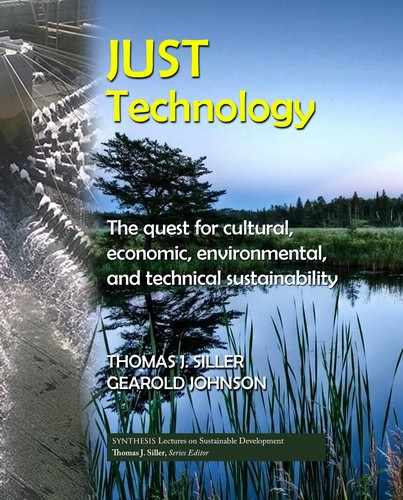70 10. CONCLUSIONS
number of miles being driven by vehicles powered by internal combustion engines. An example
related to this issue is presented below.
As surely as we are not modern luddites we are also not such optimists of the power of
technology to solve all our challenges, such as the philosophy expressed by [93]. It is true that
humans have always seemed to innovate ourselves out of difficult times, but that past does not
imply a successful future [94]. As Senge [95] says, “Today’s problems are yesterday’s solutions.
e time has come to think differently.”
10.2 THINKING DIFFERENTLY
So how do we think differently? We have presented one approach—which we call Just Technology.
Our approach adapts the conditions for a Just War for the purpose of making technology focused
decisions; we provide a series of questions to assist engineers and others to think differently.
e differences we seek include thinking beyond the technological world to incorporate other
considerations: environmental, economical, cultural, etc. We do not claim that engineers are
experts in these other areas but these considerations should be part of their thought process.
e very idea of questioning the justice in the use of technology requires thinking differently.
Engineers must not only think about the efficiency of a design but also how the design will be
used or misused.
An excellent example of thinking differently is presented in a recent book describing new
approaches being taken to handle traffic in New York City [96]. Sadik–Khan was given the task
of improving the traffic situation in New York. One of her first plans was to institute a charge for
driving into high traffic zones similar to other cities in the world, e.g., London. Not surprisingly,
this was not acceptable to New Yorkers. In her book she provides numerous examples of taking a
very different, very low tech approach to transforming the New York City’s traffic patterns. It is
worth highlighting the logic process she follows. First she recognizes that the real problem must
be identified (think about our Question 1). e following several quotes illustrate the thinking
process.
“Knowing how to change the street is only one part of the challenge. Understanding what
the problem even is in the first place can be more confounding. For most city dwellers, a
traffic problem means traffic congestion.”
“So if the capacity of road isn’t the underlying problem behind congestion, what can we do
about the volume—the supply?”
“If cities truly want a future where more people choose to take buses or trains, to bike or
walk, then cities must invest in trains, buses, bikes and better streets.”
Her design is very different from the approach she sees traffic engineers take: more ca-
pacity through more and wider streets. Instead she took the approach of creating a more people
accommodating city by creating pedestrian friendly streets and public spaces. As she proudly
..................Content has been hidden....................
You can't read the all page of ebook, please click here login for view all page.
